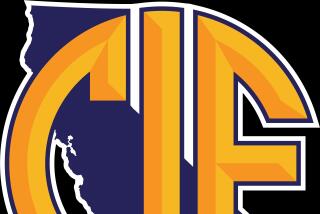A hard lesson for some athletes: It’s OK not to play when injured
- Share via
At 25, Chaz Kekipi, the athletic trainer at Anaheim Servite High, doesn’t look too far removed from his football playing days.
Thick-muscled and burly, he could easily be mistaken for a starter on one of the lines.
But don’t expect to hear him advising any of his teenage athletes to tough out a significant injury. He says he’s more likely to err on the side of caution.
And occasionally, that puts him at odds with a coach.
“They still want every kid to play through everything,” Kekipi said. “My job is to make the kid not feel afraid he’s going to be punished for being injured.”
This year, new rules by the National Federation of High School Assns. and the California Interscholastic Federation have made Kekipi’s job a little easier, taking some of the decision-making away from coaches who, while well intentioned, could be tempted to put a key contributor at risk during the heat of competition.
A game official can now remove from action any player suspected of having sustained a concussion, an edict that has been touted by some as the “When in doubt, sit them out rule.” Once removed, that player is ineligible for participation — including practice — without written clearance from a medical doctor or doctor of osteopathy.
“Head injuries last year were a lot harder to deal with,” Kekipi said. “[The coaches] felt they should have some say if a kid should play after a head injury. That’s not the case anymore.”
Servite Coach Troy Thomas said head and neck injuries are two things he doesn’t ask members of his team to “play through.” Those decisions, he said, are made by the team or family physician.
Football players at Servite also receive preseason computer neurobehavioral function testing to establish a baseline to be used in the event of a head injury. The baseline scores are compared with those conducted after a concussion to help determine the extent of the injury and when a player might return to athletic activity.
Statewide, it is estimated about 100,000 of the nearly 800,000 athletes in grades 9 through 12 who compete in “high velocity” sports such as football, soccer, lacrosse and basketball have received baseline testing.
Dr. William Hohl, an orthopedic surgeon associated with Team to Win, a group of medical professionals who volunteer their services at football games around the South Bay and Westside, said the threat of a debilitating head injury increases with each occurrence of trauma.
“If your brain gets concussed once, until it’s completely healed from the original injury it’s much more vulnerable to catastrophic injury and death even [from] second-impact syndrome,” he said. “That’s what we’re trying to prevent.”
Hohl added that “some of the coaches are very aware of the issues … and other ones are not. We’ve had some difficulty in our program over the years with coaches who just want their kid to play, even if the medical judgment is that it’s not safe.”
As for the athletes, they sometimes need to be saved from themselves.
“One of the things you realize is that adolescents don’t have a concept of the future,” Hohl said. “They don’t really get the idea that, ‘I’m injured, so the next game [should be] more important — or the end of the season, or the playoffs, or next year, or the rest of my life.’
“They’re totally focused on the right now. You have to protect them.”
Times staff writer Ben Bolch contributed to this report.
More to Read
Get our high school sports newsletter
Prep Rally is devoted to the SoCal high school sports experience, bringing you scores, stories and a behind-the-scenes look at what makes prep sports so popular.
You may occasionally receive promotional content from the Los Angeles Times.






